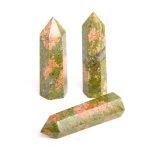Fluorite, a captivating mineral renowned for its vibrant hues and exceptional luminescent properties, transforms into a mesmerizing spectacle under ultraviolet (UV) light. When exposed to UV rays, fluorite’s hidden beauty is unveiled, revealing an otherworldly glow that has captivated collectors, scientists, and enthusiasts alike.

Understanding Fluorescence in Fluorite
Fluorescence is a phenomenon that occurs when certain materials absorb energy from an external source, such as UV light, and re-emit it at a longer wavelength. In the case of fluorite, the presence of trace elements like europium and yttrium acts as an activator, enhancing the mineral’s ability to fluoresce.
When subjected to UV radiation, these activator elements become excited, absorbing energy and transitioning to a higher energy state. As they return to their ground state, they release the absorbed energy in the form of visible light, producing the characteristic fluorescence observed in fluorite.
Spectral Variations and Intensity
The specific color and intensity of fluorescence exhibited by fluorite depend on the activator elements present. Europium-activated fluorite typically fluoresces in shades of blue or blue-green, while yttrium-activated fluorite emits a more intense green or yellow-green glow.
The fluorescence intensity of fluorite is also influenced by factors such as the concentration of activator elements, the crystal structure, and the presence of impurities. High-quality fluorite specimens with a high concentration of activator elements tend to display more pronounced fluorescence under UV light.
Practical Applications of Fluorite Fluorescence
Fluorite’s exceptional luminescent properties have found numerous practical applications in various fields:
- Gemology: Jewelers and collectors eagerly seek fluorite gemstones that exhibit intense fluorescence, adding value and aesthetic appeal to these captivating stones.
- Science and Research: Scientists utilize fluorite to study the mechanisms of fluorescence and luminescence, contributing to advancements in optics and materials science.
- Industrial Applications: Fluorite powder is employed as a phosphor in fluorescent tubes, lighting fixtures, and cathode ray tubes, providing efficient light emission in various electronic devices.
Innovative Applications for Fluorite Fluorescence
The unique fluorescence properties of fluorite present exciting opportunities for novel applications:
- Biomedical Imaging: Fluorite nanoparticles, conjugated with specific biomarkers, can be used as imaging agents to detect and visualize biological targets in vivo, aiding in medical diagnosis and research.
- Environmental Monitoring: Fluorite coatings can be utilized as sensors to detect the presence of specific chemical compounds or pollutants in environmental samples, providing real-time monitoring capabilities.
- Nanotechnology: Fluorescence microscopy techniques can be applied to investigate the properties and behavior of fluorite nanocrystals, leading to breakthroughs in nanoelectronics and other fields.
Health and Safety Considerations
It is important to note that fluorite fluorescence under UV light is not harmful to human health. However, prolonged exposure to UV radiation can damage the skin and eyes. Therefore, appropriate protective measures should be taken when handling fluorite specimens under UV illumination.
Table 1: Fluorite Fluorescence Colors and Activator Elements
| Fluorescence Color | Activator Element |
|---|---|
| Blue-green | Europium |
| Green-yellow | Yttrium |
Table 2: Factors Affecting Fluorite Fluorescence Intensity
| Factor | Effect on Intensity |
|---|---|
| Activator Element Concentration | Higher concentration leads to brighter fluorescence |
| Crystal Structure | Crystalline fluorite fluoresces more strongly than amorphous forms |
| Impurities | Certain impurities can quench or enhance fluorescence |
Table 3: Applications of Fluorite Fluorescence
| Application | Industry |
|---|---|
| Gemstones | Jewelry |
| Scientific Research | Optics, Materials Science |
| Lighting Fixtures | Electronics |
Table 4: Innovative Applications for Fluorite Fluorescence
| Application | Field |
|---|---|
| Biomedical Imaging | Medical Diagnosis |
| Environmental Monitoring | Environmental Protection |
| Nanotechnology | Nanoelectronics, Research |
Frequently Asked Questions (FAQs)
Q: What causes fluorite to glow under UV light?
A: Fluorite contains trace elements like europium and yttrium that act as activators, enabling fluorescence when exposed to UV radiation.
Q: Can I use fluorite as a light source in the dark?
A: While fluorite may glow under UV light, it does not emit enough light to be used as a practical light source.
Q: Is it safe to handle fluorite under UV light?
A: Yes, fluorite fluorescence is not harmful to human health. However, prolonged exposure to UV radiation should be avoided.
Q: Can I enhance the fluorescence of my fluorite specimen?
A: Factors affecting fluorescence intensity, such as activator element concentration and crystal structure, cannot be easily modified. However, using a stronger UV light source can increase the perceived brightness.
Q: What are some other materials that exhibit fluorescence under UV light?
A: Many other minerals, such as calcite, willemite, and scheelite, also fluoresce under UV light, displaying a wide range of colors and luminescent properties.
Q: How can I identify fluorite that fluoresces well under UV light?
A: Generally, high-quality fluorite specimens with a blue-green color tend to exhibit stronger fluorescence under UV radiation.




























